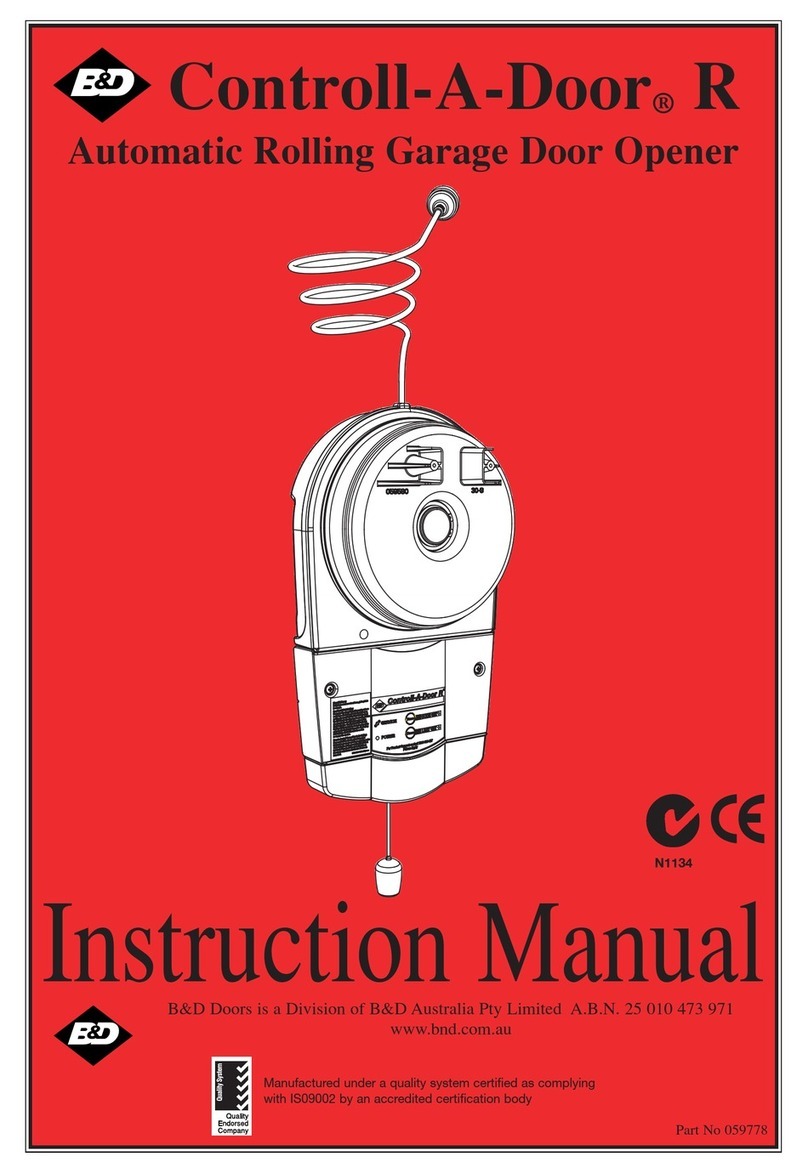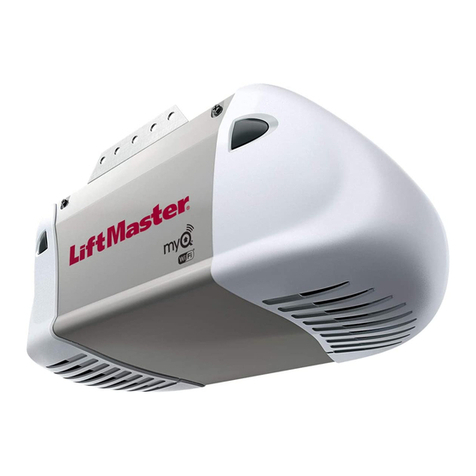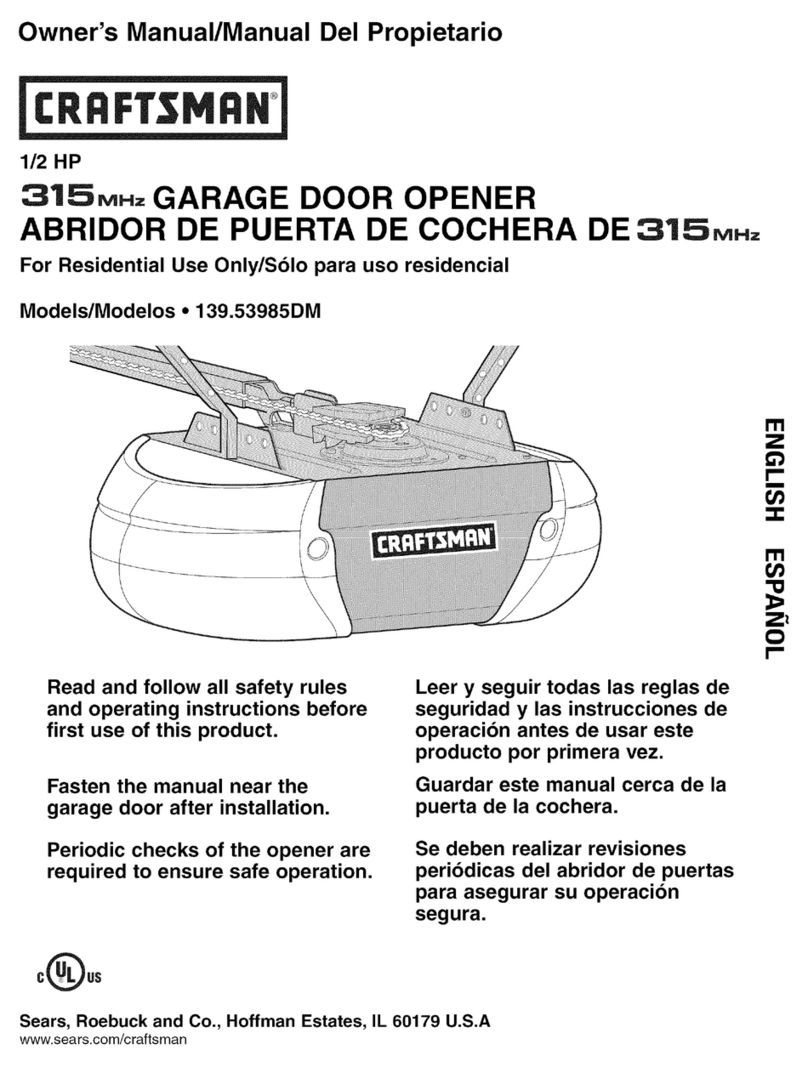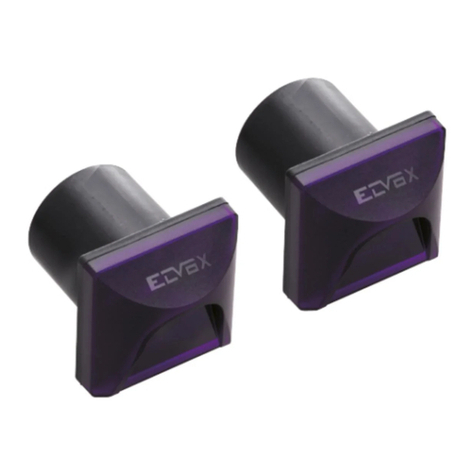Entrance Dynamics BV EDSL450 User manual

© All rights in and to this material are the sole property of Entrance Dynamics BV. Copying, scanning,
alterations or modifications are expressly forbidden without the prior written consent of Entrance
Dynamics BV. ights reserved for changes without prior notice.
Entrance Dynamics sliding door operator
EDSL450
User manual
Original in structio ns

EDSL450 User manual
2
Table of contents
evision information: .............................................................................................................................. 4
About this manual ................................................................................................................................... 5
Maintenance of your sliding door ........................................................................................................... 5
Dismantling and disposal of the door operator .................................................................................. 5
Your local service provider .................................................................................................................. 5
Door leaf - Scope of delivery ............................................................................................................. 5
1 Introduction ..................................................................................................................................... 6
1.1 Door Leaves ............................................................................................................................. 6
1.2 Drive unit ................................................................................................................................. 6
1.2.1 Motor ............................................................................................................................... 7
1.2.2 Control board EDSL-CU-450 ............................................................................................ 7
1.3 Safety System .......................................................................................................................... 7
1.4 Activation................................................................................................................................. 7
1.5 Program selector switch .......................................................................................................... 8
1.6 Program selection and interaction .......................................................................................... 8
1.7 Program selection.................................................................................................................... 8
1.7.1 Program indication .......................................................................................................... 9
1.7.2 Status indication .............................................................................................................. 9
1.7.3 Override program ............................................................................................................ 9
1.7.4 Show error and warning code ......................................................................................... 9
1.7.5 eset error ..................................................................................................................... 10
1.7.6 Initialise door ................................................................................................................. 10
1.7.7 Warning and error codes ............................................................................................... 10
2 Safety ............................................................................................................................................. 12
2.1 Safety symbols used in this manual ...................................................................................... 12
3 Operating instructions ................................................................................................................... 13
3.1 Daily Procedures .................................................................................................................... 13
3.1.1 Daily start procedure ..................................................................................................... 13
3.1.2 Daily stop procedure ..................................................................................................... 13
3.1.3 Daily function check after start procedure ................................................................... 13
4 Maintenance.................................................................................................................................. 14
4.1 Preventive maintenance schedule ........................................................................................ 14
4.2 eplacement schedule .......................................................................................................... 14
4.3 Preventive maintenance procedures .................................................................................... 15

EDSL450 User manual
3
4.3.1 Clean the door ............................................................................................................... 15
5 Troubleshooting ............................................................................................................................ 16
5.1 Checklist before you contact your local service provider ..................................................... 16
6 Declaration of incorporation ......................................................................................................... 17

EDSL450 User manual
4
Revision information:
Date: evision: Description:
21-08-2014 1.00 Initial publication
01-12-2014 1.10 Changed declaration

EDSL450 User manual
5
About t is manual
All users and owners of the EDSL450 sliding door must read, understand, and abbey the information
and instructions in this manual. Failure to do so may result in damage to, or failure of the e uipment,
and possibly injury to persons.
This manual contains information and user instructions for a sliding door. When information or
instructions are applicable to all the methods of operation or models, there are no operation types or
model numbers in the title. When information or information are applicable to specific methods of
operation or models, the applicable operation type or model names appear in the title.
Maintenance of your sliding door
To ensure your sliding door continues to operate with maximum reliability, safety and performance,
it is necessary to perform regular maintenance as specified in this user manual and in the logbook
supplied with your sliding door. This maintenance must be done by qualified service engineers,
trained to recognise possible problems, and to replace parts that have a defined life expectancy.
Dismantling and disposal of t e door operator
Dismantling of the door or parts thereof may only be carried out by qualified personnel. These tasks
are complicated and potentially dangerous. Please make a contribution to protecting the
environment when disposing of the door at the end of its functional life. Contact your local
authorised service provider for appropriate means of disposal.
Your local service provider
It is recommended that you contact your local authorised Entrance Dynamics service provider for
details about service agreements available for your sliding door.
Door leaf - Scope of delivery
The door leaves are produced by third parties, in accordance with specifications as approved by
Entrance Dynamics. However, they are not included in the scope of delivery.

EDSL450 User manual
6
1Introduction
The sliding door is designed to enable easy access to and from buildings or between building
sections.
The sliding door has 3 primary parts:
1. Door leaves
2. Drive unit
3. Activators / Safety sensors
1.1 Door Leaves
The door leaves are usually made of glass and surrounded by profiles made of aluminium. Brush
profiles are installed on the door leaves to reduce draft. The door leaves are suspended from the
carriage wheels. The door adapter profile connects to the carriage wheels and the door leaves. The
bottom of the door leaves are kept in position by the floor guides.
1.2 Drive unit
The drive unit opens and closes the sliding door. The door leaves are connected to the drive unit via
the carriage wheel brackets.
The drive unit consists of:
1. Mounting profile
2. Motor
3. Tooth belt
4. Control board
5. Carriage wheel assembly
6. Power Supply
7. Power failure backup batteries
8. Tension wheel

EDSL450 User manual
7
1.2.1 Motor
The motor, which is part of the drive unit, drives the door leaves through a tooth belt. The motor
operates on 40V DC.
1.2.2 Control board EDSL-CU-450
The control board EDSL-CU 450 is the central controller for the sliding door. It receives information
from the safety devices and motion detectors and operates the motor to open or close the door. The
control board is installed in the drive unit and is connected to:
•The motor
•Encoder for position feedback
•Power supply
•Safety activators
•Back-up battery
•Electrical lock (optional)
•External activation device (optional)
•Push buttons / intercom installation (optional).
1.3 Safety System
The safety system opens or closes the door in case of emergency. The safety system consists of:
•Panic button
•Safety sensors
•Emergency battery back-up
•Fire alarm (optional)
1.4 Activation
The different types of optional activators are:
•adar (motion detection)
•Active infrared (motion and/or presence detection)
•Key switch (manual)
•Push button (manual)
•Hand-transmitters
•Etc.
The activators give an impulse to open or close the door. The radar and active infrared activators are
installed close to or on the drive unit. The other activators can be installed in other positions, and are
not necessarily in proximity to the drive unit.

EDSL450 User manual
8
1.5 Program selector switc
The Program switch is used to select the required program. The program switch can be installed close
to the door or at another location in the building.
1.6 Program selection and interaction
The program switch is used to select the program that will be used for the sliding door.
1.7 Program selection
Selection is done with a key switch. The switch can be positioned in six different positions, five of
which are programs and one is used for error reporting and reset (position F).
See the table below for the list of programs that can be selected. To prevent multiple changes to the
selected program while switching from one to another, the switch has to remain stationary for more
than two seconds before the new program is activated.
Position Function
A Program close. Door is closed and locked. Sensors will not open the door. Only
porter input can be used to open the door.
B Program exit-only + full open. Door opens on activation of inside motion sensor.
An open door will remain open if either inside or outside presence sensor is
active. Door is opened to the full open position.
C Program automatic + full open. The door will open on activation of all sensors,
inside or outside. Door is opened to full open position.
D Program automatic + reduced open. The door will open on activation of all
sensors, inside or outside. Open position will be to the reduced open position or
full open position depending on the activator. This program cannot be used in
escape routes.
E Program open + full open. Door opens and remains open during this program
regardless of sensors active.
F Error reporting and reset. When the controller has a warning or is in error, placing
the switch in this position will cause program switch to display the warning or
error code.
A
B
C
D
E
F

EDSL450 User manual
9
Program change may not be possible if the program is overridden in the door
controller.
For added security the key can be removed from the switch when positioned in any position, except
the reset position (F).
1.7.1 Program indication
The active program of the door controller is presented with an indicator. If the program switch is at
that program the indicator lights continues. If the program selection of the switch is overridden, then
the indicator will blink.
If a program is active that the program switch is not capable of displaying or during loss of
communication to the controller the program switch will rotate the program selection indicators as
the indication that no program can be displayed.
1.7.2 Status indication
Next to the service symbol is a multi-colour indicator for status information, such as warning and
error.
Status indicator colours
Colour Description
Green Ok, no errors or warnings active.
Orange (continuous) Warnings present which may prevent the door from functioning correctly.
Some warnings can be reset with the program switch, but most must be
resolved otherwise.
ed (blinking) Door controller is in error state. Errors can be reset with the program switch
(retry).
Orange (pulsing) Door controller is in service mode. Service mode cannot be altered with the
program switch.
1.7.3 Override program
The program used by the door controller can override the selection made with the program switch.
The indicator will always show the program selected (if possible). If the active program is different then
the program selected with the switch the indicator will blink.
There are two possible methods to override the program – with active inputs and temporary (pulses).
The temporary override can be reset by selecting the active program. After it has been selected the
override is cancelled. As a result the indicator will be lid continuously. Afterwards, the program can be
changed by the program switch again.
1.7.4 S ow error and warning code
If an error or warning is active on the controller the code can be shown on the program indicators. A
warning or error is indicated with a multi-colour indicator next to the service symbol. When the
program switch is positioned in the service position, the warning or error code will be shown. Whether
the shown code is a warning or error is determined by the status indicator. The code is shown using all
six program indicators, including the service symbol. Fout! Verwi zingsbron niet gevonden. shows the
symbols and added labels for clarity. The labels are used in the warning and error tables (table and
table).

EDSL450 User manual
10
Multiple warnings can be active simultaneously. However, only one warning will be shown. The door
controller determines what code will be shown.
1.7.5 Reset error
To reset the error, the reset position must be selected for more than 1 second. On selecting a
program position the reset command is transmitted. While the key switch is reset position the
warning or error code is shown instead of the active program.
1.7.6 Initialise door
The door can be re-initialised by selecting the reset position for more than 3 seconds, but less than 8
seconds.
If the reset is selected more than 8 seconds no actions are performed, but the warning or error code
is shown instead of the active program.
1.7.7 Warning and error codes
1.7.7.1 Table Warning codes
A
B
C
D
E
F
Warning description
Service required
Battery missing
Battery low voltage
Battery operation
Battery hardware of controller
adar inside bad
adar outside bad
AI inside bad
AI outside bad
I2T activated
Motion disabled
Fire active
Program flow error
Escape module error
AI inside monitoring error
AI outside monitoring error
Mechanical escape bad
Side screen sensor monitoring error
Sensor supply overload
Indicator is off
Indicator is on

EDSL450 User manual
11
1.7.7.2 Table Error codes
A B C D E F Error description
Supply failure
Current offset error
Temperature error
Motor drive fault
Motor inverted while operational
Connect motor
Motor shorted
Motor and/or encoder
Encoder error
Low home current
Escape motor movement direction
Memory error
Overvoltage error
Door controller error
Door mechanical connection
No close position
No open position
Software error
Untested unit

EDSL450 User manual
12
2Safety
2.1 Safety symbols used in t is manual
The following safety symbols are used in this manual:
Indicates a general warning
•Only authorized persons are permitted to operate the door.
•ead and fully understand the safety instructions before you operate or do maintenance on
the door.
•Always obey local health and safety regulations when you operate or do maintenance on the
door.
•Make sure there are no persons or equipment in the working area of the door before you
operate the door.
•Do not remove or immobilize safety equipment installed on or near the door.
•Do not operate the door if it has any defects. eport defects to the supervisor immediately.
•Do not operate the door after the date of the next scheduled maintenance. The date of the
next scheduled maintenance is shown in the logbook.
•Do not modify the door. Unauthorized modification can cause danger to people and affect
the function and safety of the door.

EDSL450 User manual
13
3Operating instructions
3.1 Daily Procedures
3.1.1 Daily start procedure
•Visually check the door for damage
•If damage is found:
oApply suitable warning signs around the door and on the door leaves.
oContact your local service provider.
•If no damage is found:
oSet program selector to the required position.
3.1.2 Daily stop procedure
•Examine the door for damage.
•If damage is found:
oApply suitable warning signs around the door and on the door leaves
oContact your local service provider.
•If no damage is found:
oIf the door is in an escape route and/or the only entrance, make sure that no person is in
the building.
oSet the program selector to the required position.
3.1.3 Daily function c eck after start procedure
•Approach the door from both sides and make sure the door opens and closes.
•If the door does not operate correctly contact your local service provider.

EDSL450 User manual
14
4Maintenance
According to the EN16005, DIN18650, and AutSch for escape routes, the installer retains
responsibility for the safe operation of the sliding door, only when user instructions are obeyed and
the service checklist and scheduled maintenance tasks are done by authorised/certified people. If
not, the owner takes over all responsibility. The owner is responsible that maintenance is carried out!
4.1 Preventive maintenance sc edule
Frequency Part Tasks
Daily
Door complete
Do the daily start procedure
Do the daily function check after
start
procedure
Do the daily stop procedure
Make sure the door leaves are clean
but visible
Make sure the door leaves are free of
obstacles (boxes, goods etc.)
Floor guides
Make sure the leaves are guided
properly and remove any debris from
floor/track.
follow the local
regulations but not
less as every 12
months
Door complete
Annual inspection made by authorised
Service Partner.
4.2 Replacement sc edule
Apart from regulatory maintenance, we at Entrance Dynamics think it is important for our doors to
be treated the same way as a vehicle; change the oil and the tires at the correct time. With
preventive replacement you make sure the product keeps its functionality, safety and classification.
It keeps the warranty valid and prevents unexpected and expensive breakdowns or accidents. The
following list contains the recommended replacement frequencies.
Frequency
Tasks
Every year or 100.000 openings
eplace the
floor guide
Every 3 years or 250.000 openings
eplace the backup batteries
eplace the replaceable part of the key switch
eplace the mohair brush
eplace the tooth belt

EDSL450 User manual
15
Frequency
Tasks
Every 4 years or 500.000 openings
eplace the carr
iage
wheels
eplace the wheel track
eplace the anti-derailment wheels
Every 7 years or 750.000 openings
eplace the drive unit
eplace the electric lock
The economic life time of the products is on normal use and in a normal environment, estimated on
10 years or 1.000.000 cycles,
Therefore, after 10 years or 1.000.000 cycles, a major overhaul has to be executed in order to extend
the life time and ensure a safe and reliable function.
The following items have to be considered for replacement:
•Hook lock
•Combined adars/Sensors
•Safety devices
•Other activators
•Control unit
•Program switch
•Emergency button
4.3 Preventive maintenance procedures
4.3.1 Clean t e door
Do not use the door leaf or Drive unit to support a ladder when you do
maintenance on a door.
Always use ladders as specified in local health and safety instructions
D
o not use a high pressure washer
to clean the door.
1. Do the Daily Stop procedure.
2. Use a soft clean brush and mild detergent to clean the inside and outside of the door leaf.
3. Use a soft clean brush and mild detergent to clean the outside of the adars/Sensors/Photocells
4. If damage is found, contact your local service provider for repairs.

EDSL450 User manual
16
5Troubles ooting
This chapter contains troubleshooting information for the user of an automatic sliding door. If a fault
is not described below, contact your local service provider for assistance.
Symptom
Cause
Solution
Door does not
open.
No power
Make sure the main switch/and fuse are
serviceable. Switch the power supply on.
Program Selector in
"close" position.
Select program selector to the "automatic"
position.
Do the daily start procedure
Door does not
close
Object detected by
Sensor/ adar
Move the object outside the detection area.
No power
Make sure the main switch/and fuse are
serviceable
Switch the power supply on.
Program Selector in
"open" position
Change the position on the program selector.
If it is necessary to adjust the opening or closing speed, or the sensitivity or detection field of sensors,
please contact your local service provider.
5.1 C ecklist before you contact your local service provider
•Make sure the main electrical power supply is on
•Make sure the program switch is in the correct position.
•Make sure there are no obstacles beside, under or between the door leaves
•Make sure the inside and outside sensors are clean and free of obstructions
•Make sure the safety sensors are clean and free of obstructions
•Make sure the photocells are clean
•Make sure bottom guides are running freely.
•Perform "reset" on the program switch.

EDSL450 User manual
17
6Declaration of incorporation
We Entrance Dynamics B.V.
Breeuwhamer 6
1648 HG De Goorn
Netherlands
Declare under our sole responsibility that the type of equipment:
Sliding door operator type EDSL450
Sliding door retrofit kit type EDSL450
Is in compliance with the following directives:
2006/95/EC Low Voltage Directive
2004/108/EC ElectroMagnetic Compatibility Directive (EMCD)
2006/42/EC Machinery Directive (MD) with the following essential health and safety
requirements:
1.1.2, 1.2.1,1.2.2,1.2.3,1.2.4.2,1.2.6,1.3.9,1.4.3,1.7.2,1.7.4,1.7.4.1,1.7.4.2.
2002/95/EC estriction of Hazardous Substances ( oHS)
Technical documentation for safe integration is provided
Harmonized European standards which have been applied:
EN 60335-1 EN 61000-6-2 EN 61000-6-3 EN ISO 13849-1 EN 16005
Other standards or technical specifications, which have been applied:
DIN 18650-1/-2 EN 60335-2-103
EC type examination or certificate issued by notified body
IFT 0757: No 14-000152-PB01
SP 0402 : No SC0707-14
(for full address, please contact Entrance Dynamics B.V.)
The equipment must not be used until the installation organisation, by issuing a Declaration of
Conformity, has declared that final installed automatic door system has been subject to a risk
assessment in compliance with Machinery Directive 2 6/42/EC.
The manufacturing process ensures the compliance of the equipment with the technical file, and is
regularly accessed by 3
rd
party.
Table of contents
Popular Garage Door Opener manuals by other brands

Chamberlain
Chamberlain 8365W manual
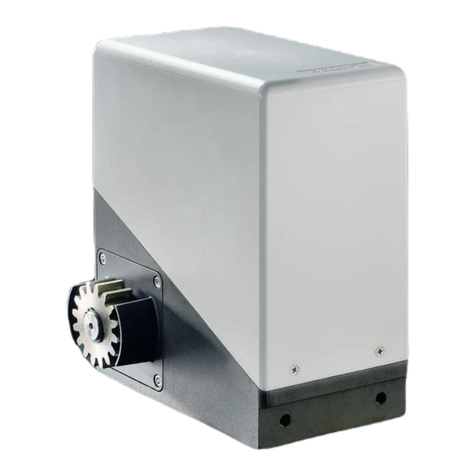
Erreka
Erreka TORO installation guide

MFZ Ovitor
MFZ Ovitor TVR(FC) 5 Operating and maintenance instructions
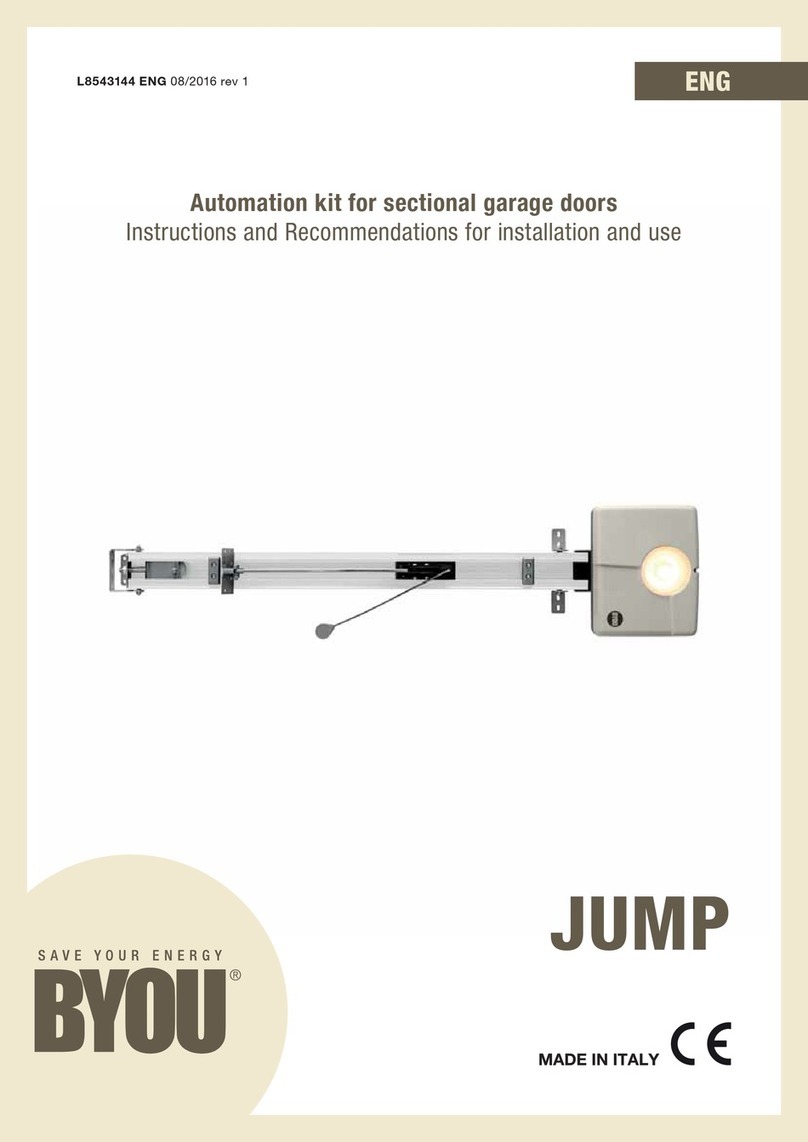
BYOU
BYOU JUMP Instructions and Recommendations for installation and use

Craftsman
Craftsman 139.53954 owner's manual
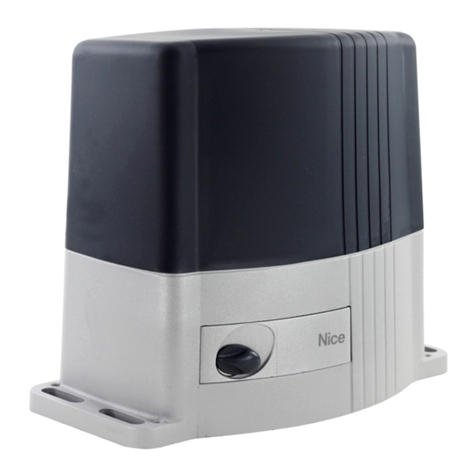
Nice
Nice THOR Instructions and warnings for the fitter

Craftsman
Craftsman 139.53993D owner's manual
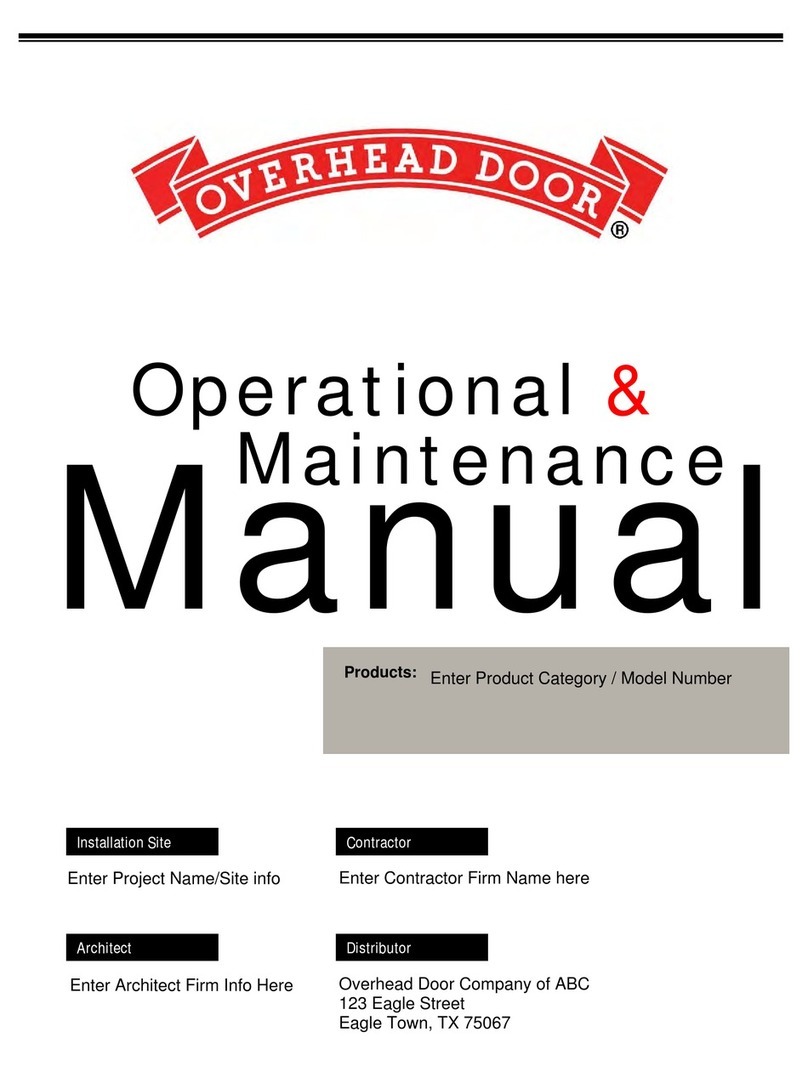
Overhead door
Overhead door RapidSlat 611 Operational & maintenance manual
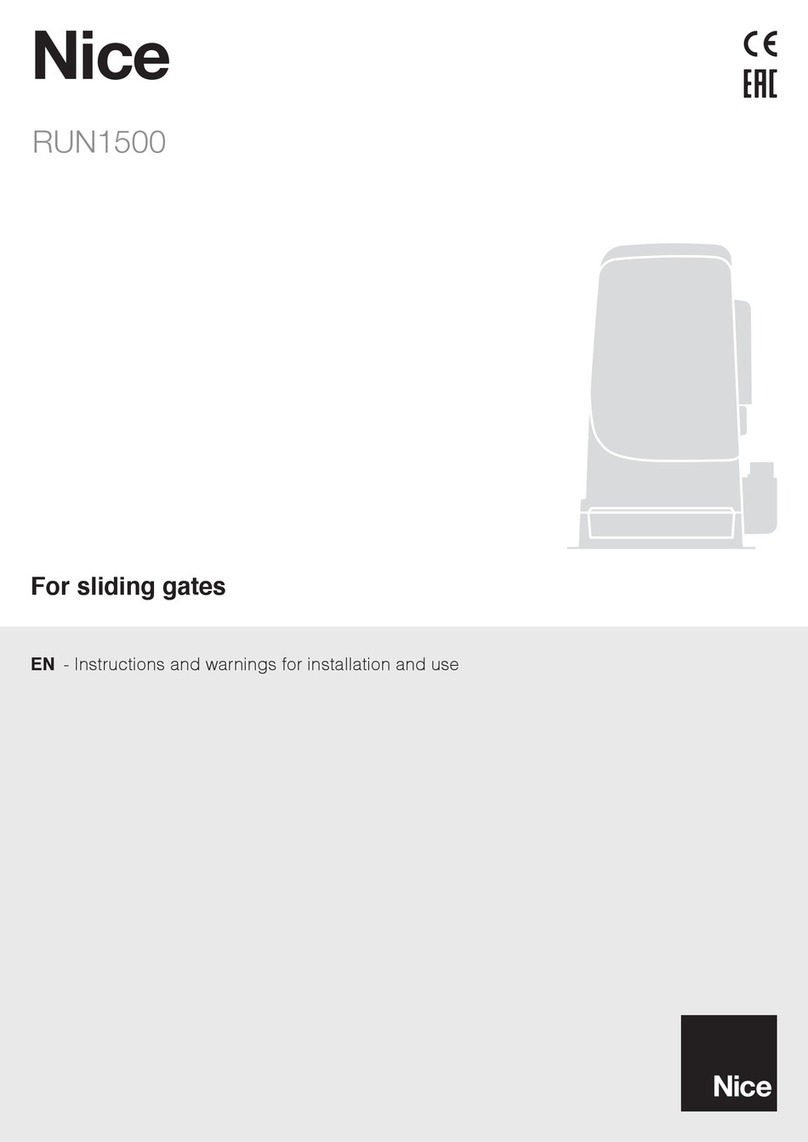
Nice
Nice RUN1500 Instructions and warnings for installation and use
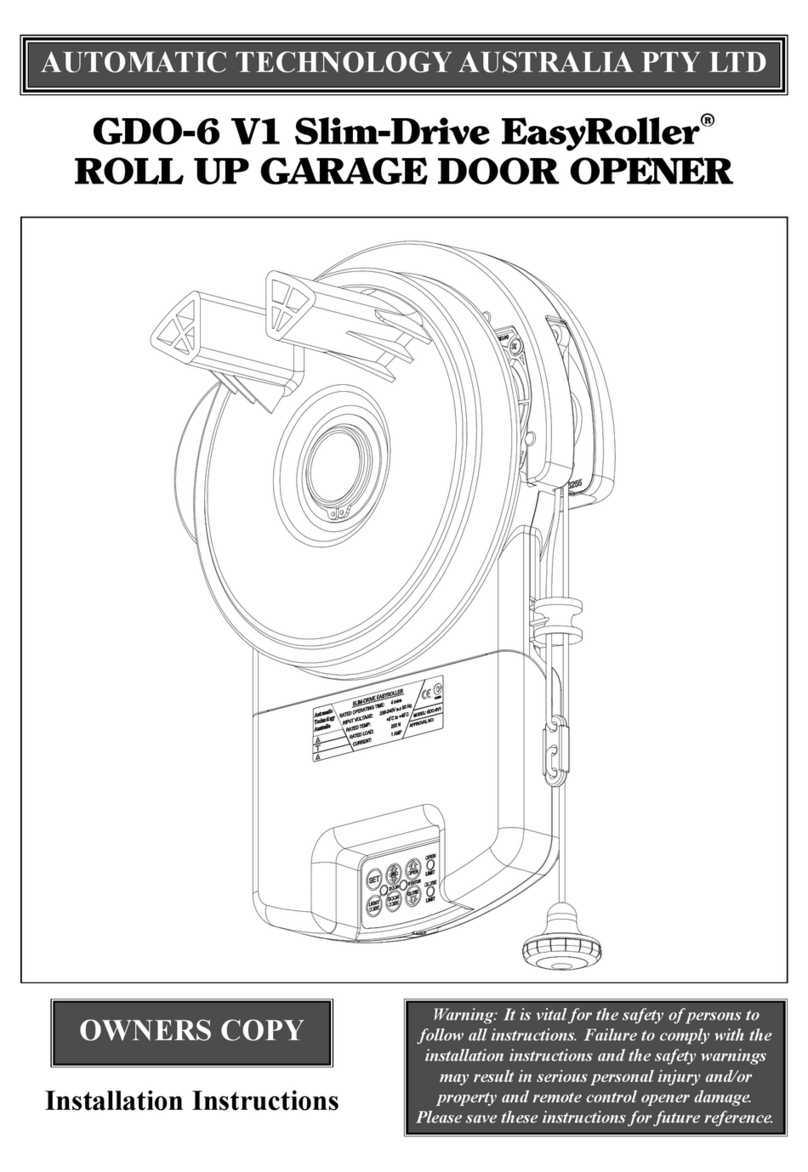
Automatic Technology Australia
Automatic Technology Australia GDO-6 V1 Slim-Drive EasyRoller installation instructions
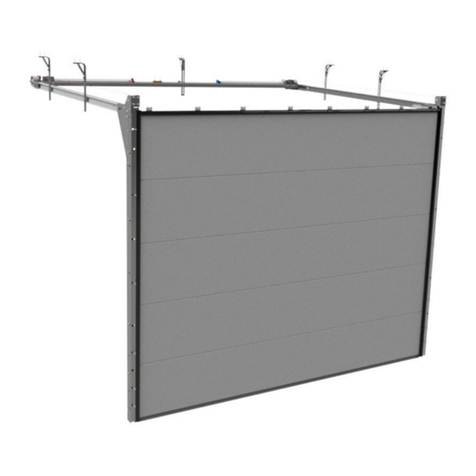
LOBAS
LOBAS Major LO TF Assembly instruction
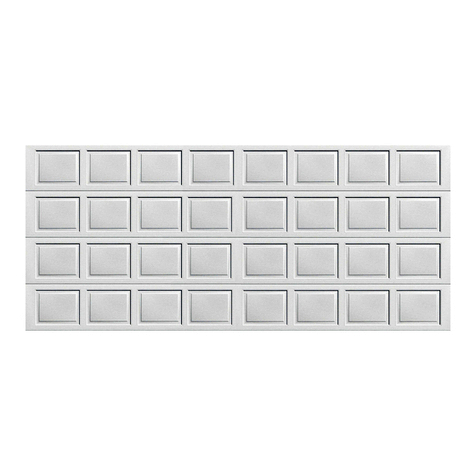
Wayne-Dalton
Wayne-Dalton 9100 Installation instruction and owenrs manual
